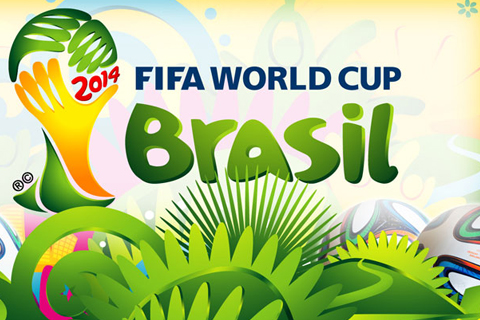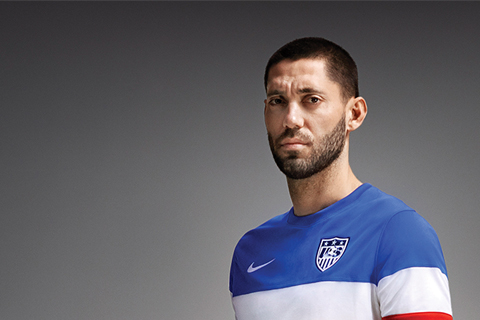Navigating the 2014 World Cup Games

How does the World Cup work?
Part I: Group Play
Not every body gets to go to the World Cup (except for the host country, whose team automatically qualifies). Qualifying national teams are divided into groups, randomly assigned through a draw process, each of which is labeled by letters A through H. Each group is made up of four teams, who all play each other. Group Play begins on June 12, when Brazil plays Croatia.
Group A: Brazil, Croatia, Mexico, Cameroon
Group B: Spain, Netherlands, Chile, Australia
Group C: Colombia, Greece, Côte d’Ivoire, Japan
Group D: Uruguay, Costa Rica, England, Italy
Group E: Switzerland, Ecuador, France, Honduras
Group F: Argentina, Bosnia-Herzegovina, Iran, Nigeria
Group G: Germany, Portugal, Ghana, USA
Group H: Belgium, Algeria, Russia, Korea Republic
When does the US Men’s National Team play?
Monday, June 16 Ghana vs. United States (Estadio do Maracana) on ESPN (5 p.m., CST)
Sunday, June 22 United States vs. Portugal (Arena Amazonia) on ESPN (5 p.m., CST)
Thursday, June 26 United States vs. Germany (Arena Pernambuco) on ESPN (11 a.m., CST)
The bottom two teams in each group are eliminated; the top two proceed on to the next level.
Part II: Knockout Stage, or Round of 16
The 16 teams that were in the top of group play now go up against each other. The first place team in Group A plays Group B’s second place team; first place in C plays second in D; the second place in A plays first in B, and so on. The Round of 16 begins on Saturday, June 28.
Unlike Group Play, this is single elimination. The winning eight proceed to Quarterfinals (Friday, July 4—how great would it be to see the US play on this day?); the winning four progress to Semifinals (Tuesday, July 8).
Part III: Finals
The third place game will take place on Saturday, July 12, at Estadio Nacional Mane Garrincha in Brasillia.
The two winning teams from Semifinals will play on July 13 for the 2014 FIFA World Cup Final, which will be held this year Maracana Stadium in Rio de Janerio and shown on ABC.
Stuff to Know:
“Group of Death”:When the four-team draw randomly assigns a very difficult first round. For example: the 2010 World Cup finalists, the Netherlands and Spain, are both in Group B.
In group play, winning teams are awarded three points; for a tie, one point. A loss gets 0. These points are added up to give more than a simple W-L record.
There is no such thing as a tie after the group play round. Tie breaking is complicated. First, there are two 15-minute additional time segments. If the game is still a tie at the end of both, a winner is decided by PKs (penalty kicks), where shooters go up against the goal keeper.
Maracana Stadium in Rio was built for the 1950 FIFA World Cup and seats more than 82,000 spectators. The seats in the stadium are yellow, blue, and white; the Brazilian flag is yellow, blue, white, and green. It will also host opening and closing ceremonies for the 2016 Summer Olympics and 2016 Summer Paralympics.
After a match, players often swap jerseys. It’s a tradition that started back in the 1930s and appeared in World Cup play in 1954. It’s a sign of sportsmanship. Pele’s jersey from the 1970 cup wound up in the hands of an Italian player, whose family sold the jersey in 2002 for $310,000.
Soccer players may strip off their jerseys in celebration after scoring a goal, though they can be given a yellow card for a penalty. The most famous incident is when Brandi Chastain made a penalty kick in the 1999 Women’s World Cup after 120 minutes of intense play to win the match. Chastain joyously stripped off her jersey just before being mobbed by the rest of the USWNT. Her triumphant expression has become one of soccer’s iconic images.
Yes, there’s a FIFA Women’s World Cup and it’s next held in Canada in 2015 from June 6 to July 5. It’s held every four years and set up like the men’s tournament, though there are less teams and so the Group Play round will consist of six groups of four teams. In 2011, the FIFA Women’s World Cup was held in Germany. Japan won—the first Asian team to ever win a FIFA World Cup—after outscoring the US in a penalty shoot-out. Since the Women’s World Cup was first held in 1991, the US team has won twice (’91, ’99) and hosted once (’99).
Where to Watch
All 64 games will be broadcast live on ABC and ESPN/ESPN2. Click to see a complete schedule of televised games.
The US Men’s National Team Roster
PLAYER POS. HT. WT. HOMETOWN CLUB/COLLEGE
Jozy Altidore F 6-1 175 Boca Raton, Fla. Sunderland (England)
DaMarcus Beasley D 5-8 145 Ft. Wayne, Ind. Puebla (Mexico)
Kyle Beckerman M 5-10 165 Crofton, Md. Real Salt Lake
Alejandro Bedoya M 5-10 160 Weston, Fla. Nantes (France)
Matt Besler D 6-0 170 Overland Park, Kan. Sporting Kansas City
Michael Bradley M 6-2 175 Manhattan Beach, Calif. Toronto FC
John Brooks D 6-4 170 Berlin, Germany Hertha Berlin (Germany)
Geoff Cameron D 6-3 185 Attleboro, Mass. Stoke City (England)
Timothy Chandler D 6-1 180 Frankfurt, Germany Nuremberg (Germany)
Brad Davis M 5-11 165 St. Charles, Mo. Houston Dynamo
Clint Dempsey F 6-1 170 Nacogdoches, Texas Seattle Sounders FC
Mix Diskerud M 6-0 150 Oslo, Norway Rosenborg (Norway)
Omar Gonzalez D 6-5 210 Dallas, Texas LA Galaxy
Julian Green M 5-7 140 Tampa, Fla. Bayern Munich (Germany)
Brad Guzan GK 6-4 210 Homer Glen, Ill. Aston Villa (England)
Tim Howard GK 6-3 210 North Brunswick, N.J. Everton (England)
Aron Johannsson F 6-0 165 Mobile, Ala. AZ Alkmaar (Netherlands)
Fabian Johnson D 6-0 155 Munich, Germany Borussia Moenchengladbach (Germany)
Jermaine Jones M 6-0 170 Chicago, Ill. Besiktas (Turkey)
Nick Rimando GK 5-11 180 Montclair, Calif. Real Salt Lake
Chris Wondolowski F 6-0 165 Danville, Calif. San Jose Earthquakes
DeAndre Yedlin D 5-8 150 Seattle, Wash. Seattle Sounders FC
Graham Zusi M 5-10 160 Longwood, Fla. Sporting Kansas City
Texas Ties on the USMNT

Captain Clint Dempsey hails from Nacogdoches and defender Omar Gonzalez grew up in the Dallas neighborhood of Oak Cliff. While Brad Davis (midfielder) is not originally from Texas, he plays in the MLS with the Houston Dynamos.
Who Can Play on a National Team?
Notice those guys from other countries on the US roster? You can play for a national team if you weren’t born there. The FIFA statute states that, if a player has assumed a new nationality and hasn’t played in an official competition for an association, he is eligible to play for the new representative team if he meets one of these conditions:
a) He was born on the territory of the relevant Association;
b) His biological mother or biological father was born on the territory of the relevant Association;
c) His grandmother or grandfather was born on the territory of the relevant Association;
d) He has lived continuously for at least five years after reaching the age of 18 on the territory of the relevant Association. (Article 17, acquisition of a new nationality)






